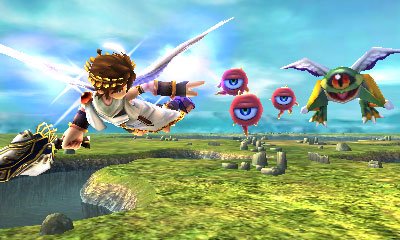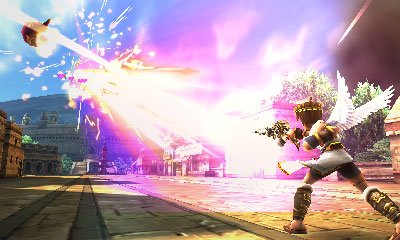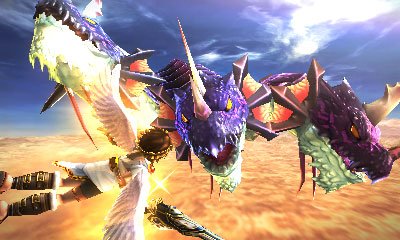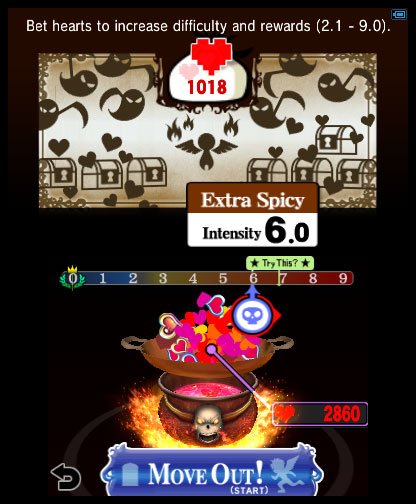Kid Icarus: Uprising preview looks like Pit was worth waiting for
Our extended hands-on time reveals surprisingly intuitive controls and colorful action on both land and sky
Since Kid Icarus: Uprising was first announced as a 3DS launch title back at E3 2010, we haven't seen much of the Pit's long-awaited, slightly delayed adventure. Until now, that is – we recently got a chance to sit down with Uprising for a good two hours and check out several chapters of the game in their entirety.
Much ado has been made about Uprising's potentially awkward controls, but they're actually quite simple. To recap the basics: you control Pit's movement with the analog slider, aim your weapon with the stylus, and attack/fire with the left bumper. The tricky part is figuring out how to keep your thumb on the analog pad and your stylus poised on the lower screen in a way that's comfortable for you. It took a few small adjustments, but we quickly figured out how to make it work.
Say what you will about the new stand peripheral, but it actually works great with Kid Icarus. With the 3DS resting firmly on its shelf, the stand feels totally solid and stable, and the angle is just right for playing at a desk or table. Left-handed players should definitely consider investing in a Circle Pad Pro to avoid the awkwardness of using the stylus in the right hand though, but based on how the Circle Pad Pro attaches to the 3DS, it looks like the two peripherals aren't compatible. So even though lefties will have to choose between the comfort of the stand and the comfort of using the right slider pad, it's still nice that Nintendo is actually thinking of us by including the support for both control schemes.

Each chapter we played began with a short-ish aerial segment followed by a longer on-foot segment, so that seems to be the typical formula for each level. The aerial parts are like an on-rails shooter where you can move Pit around the frame using the slider but can't control the camera or Pit's speed through the air. Constant movement is key to dodge enemy attacks too, since they'll target Pit quickly if he stays in one place too long.
The non-flying part of each level is a little more complex. With Pit grounded, you now have full control of the camera, and you can swing it around quickly by flicking the stylus and then tapping to stop, which comes in handy when multiple enemies are flanking you. Pit also has dodging/strafing move and a forward charge attack that some enemies are particularly vulnerable to, and we learned quickly that not all enemies can be taken down with long-range attacks (metroids in particular need to be taken out with melee attacks).

Each chapter we played had an initial encounter with a boss during the flying portion of the level that culminated in a final showdown at the end of the ground section. Out of the three bosses we saw, the three-headed dragon Hewdraw was our favorite, whose primary head sassily thanked us for dispatching of his two other heads before we put him down for good. In a particularly cool aerial moment, we swooped down from the air to run across his scaly back for a sneak attack. RIP Hewdraw.
There are eight weapon categories – blade, bow, cannon, claws and so on – and each has its pros and cons. Each weapon has both a melee and a ranged attack (the left bumper triggers one or the other depending on your proximity to the enemy), and some weapons are better at close quarters combat while others excel at long range attacks. Pit can also equip a variety of special abilities at the start of each chapter, like limited-use weapons (mega laser, angelic missile) or emergency health recovery. It takes some experimentation to see which loadouts are most effective in each chapter, so it's worth replaying with different equipment to see what works best.
Weekly digests, tales from the communities you love, and more

And speaking of replayability, you can set the difficulty level on a long sliding scale at the beginning of each chapter, which strongly affects how each level plays. The harder the difficulty you select, the better weapon drops you'll get, so there's an incentive to push yourself as much as possible.
You can't just select any difficulty with no penalty though – adjusting the difficulty up or down from the standard setting will cost you some hearts, which are the universal in-game currency. Decreasing the difficulty will cost you a few hearts depending on how far down you go, but increasing the difficulty is more like a bet – wager some hearts, and if you complete the chapter sucessfully you get your hearts back and then some, but if you die you lose them. During our demo we replayed one of the earlier stages with the difficulty ramped up substantially, and we definitely noticed a huge difference.

To top it off, Kid Icarus: Uprising looks absolutely gorgeous too. Some of the aerial landscape shots as Pit soars over each level are rather breathtaking, and easily some of the prettiest stuff we've seen on 3DS. Look for more info on Uprising as we get closer to its March 23 release.



